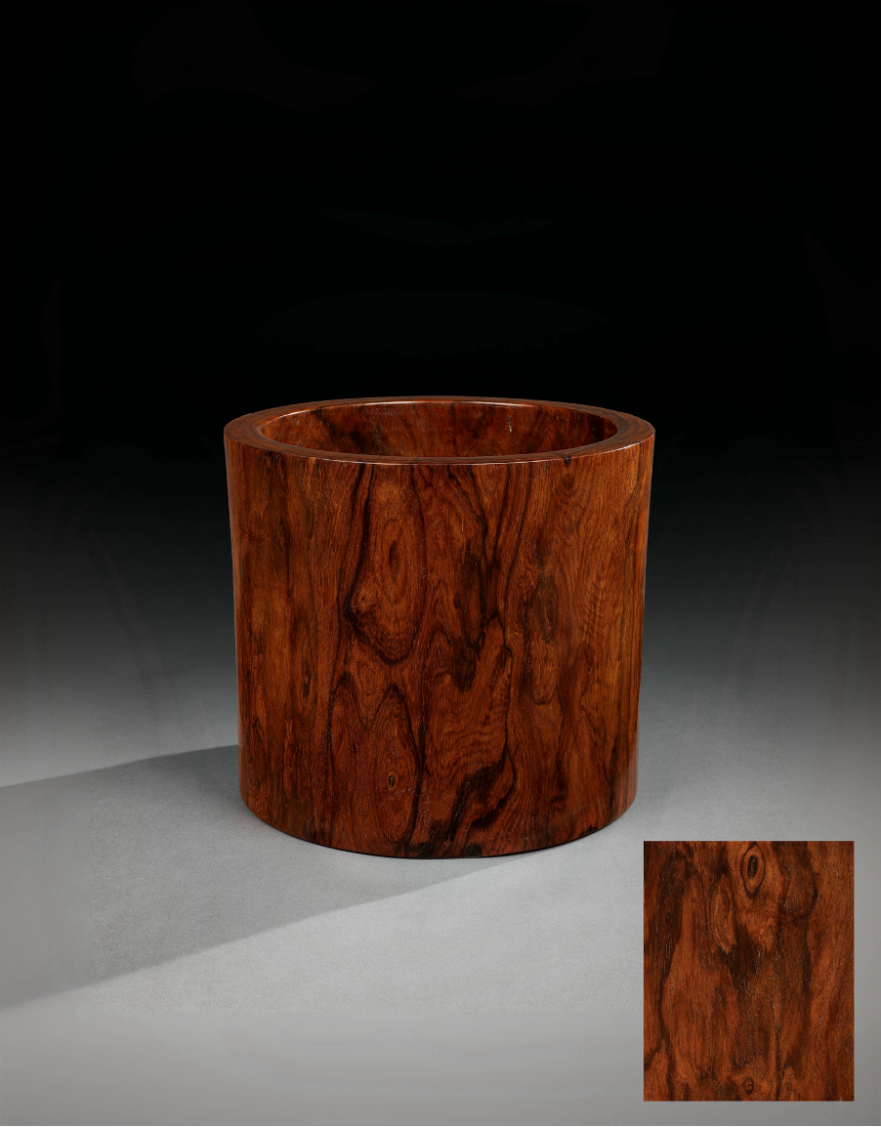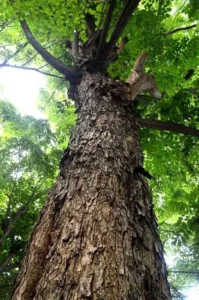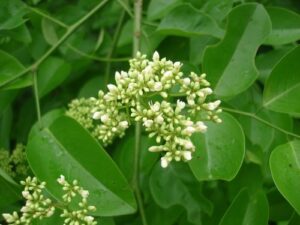Huanghuali, or “yellow flowering pear” wood, is a rare species of rosewood, mainly produced in Hainan Province and once adorned Imperial abodes. The botanical classification is Dalbergia odorifera.
Matched with the rapidly increasing demand for Chinese antiques, prices for Huanghuali furniture have skyrocketed over the past five years due to increased demand and limited supply. The volume of new Huanghuali wood originating in Hainan is very limited, it has now been placed under State protection and might risk going extinct.
Originally known as huali or hualu, the modifier huang (yellowish-brown) was added in the early twentieth century to describe old huali wood which surfaces had mellowed to a yellowish tone due to long exposure to light.
The colour can range from reddish-brown to golden-yellow. As member of the rosewood family, Huanghuali stands for rarity, beauty and in today’s Chinese furniture market, high prices. It is believed that there are less than 10,000 pieces of Huanghuali furniture left in the world.
Huanghuali is possibly the hottest category of furniture and works of art in the world today.
Hainan Island appears to be the main source of the wood, typically growing at altitudes below 600 meters on low hills and terraces, such as Diaoluo Mountain and Jianfeng Ridge; although it is believed that there are similar species in North Vietnam, Indochina, Guangxi and other islands of the South China Sea.
Dating to the mid-Ming period, Huanghuali furniture is believed to have been prized by the very wealthy, the upper classes and officials reaching its zenith during the mid-to-late Ming period. As the final feudal Dynasty under Han rule, the Ming era witnessed the full maturation of a culture deeply rooted in Confucian principles. The emergence of Huanghuali furniture during this time is inextricably linked to the intellectual achievements and aesthetic sensibilities of the Scholar-gentry class.
The choice of materials for furniture was closely tied to the cultural, ethnic, and political needs of the ruling class. The auspicious element for the Ming imperial family was “fire”; Huanghuali wood with yellow colour was also associated with the element of fire, thus becoming the material of choice for the Ming royalty and high-ranking officials. By the mid-to-late Ming Dynasty period, the popularity of Huanghuali had reached obsessive levels among the populace.
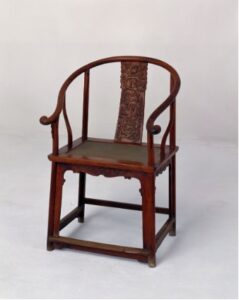 明代黄花梨木雕螭纹圈椅 故宫博物院 Ming Dynasty Palace Museum, Beijing, China
明代黄花梨木雕螭纹圈椅 故宫博物院 Ming Dynasty Palace Museum, Beijing, China
Huanghuali wood grows slowly and is scarce in resources, difficult to harvest, with the saying that it takes “five hundred years to grow to the thickness of a bowl’s rim.” Due to its delicate grain, warm colour, hard texture, stable nature, and resistance to deformation, Huanghuali wood has been widely used in Ming and Qing furniture and Scholars’ items, making it highly valued by royalty and literati.
Due to slow growth, large pieces of Huanghuali that could be obtained from nature were nearly extinct by the late Ming and early Qing dynasties. The Qing imperial court had stored some Huanghuali timber, but more than half of it was used for constructing the Qianlong Garden. The remaining stock was completely depleted during Yuan Shi Kai’s coronation. As newly planted huanghuali takes over 200 years to mature, experts predict that the shortage of Huanghuali could last for up to 200 years.
Interestingly, Huanghuali wood is considered to have medicinal value in traditional Chinese medicine research including lowering blood pressure and blood lipids, activating blood circulation, removing blood stasis, stopping bleeding, and relieving pain. It is mostly used to treat the pain associated with coronary heart disease and bruises.
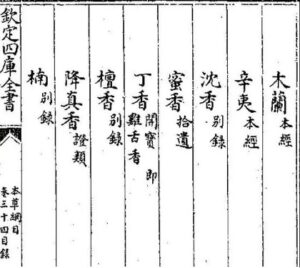 《欽定四庫全書》本《本草綱目》Traditional Chinese medicine book Bencao Gangmu from the Qinding Siku Quanshu
《欽定四庫全書》本《本草綱目》Traditional Chinese medicine book Bencao Gangmu from the Qinding Siku Quanshu
COLOUR
The colour of Huanghuali ranges from golden-yellow to reddish-brown.Originally, the wood was known only as “huali,” which means “pear tree flower.” “Huang” (yellow) was added to describe the surface of old huali wood that has mellowed over years of exposure to light.
SCENT
Huanghuali, known by its scientific name as Dalbergia Odorifera has a sweet fragrance that distinguishes this wood from Hongmu, a similar-looking but pungent-smelling wood. It has an airy and slightly milky aroma, making it a pleasant smell when you work with it.
GRAIN

Huanghuali is valued for its rich amber tones and abstract figural patterns, including the most distinctive and precious one the “Ghost Face”.
Classical “Ghost Face” pattern forms are due to seasonal weather resulting in scars or burls growths on the trunk. The swirling grain pattern is highly valuable with a saying it “worth a thousand gold.” In addition to ghost face, there are also “cloud and water,” “silk and bamboo” and “landscape” patterns. The richness and beautiful abstract grain of Huanghuali is cherished and valued by traditional Chinese Scholars and reflects an artistic pursuit that reveres nature.
Huanghuali is a very durable material, impermeable to water and insects. The strength of the wood made this the ideal material to withstand the physical demands of the tenon-mortice construction of Chinese furniture.
黄花梨是一种稀有的红木树种,主要产自海南省,曾用于装饰皇家居所,其植物学分类为降香黄檀。随着市场对中国古董需求的迅速增长,黄花梨家具的价格在过去一段时间内因需求增加和供应有限而大幅上涨。海南产的新黄花梨木数量非常有限,目前已被列为国家保护对象,可能面临灭绝的风险。
黄花梨最初被称为花梨或花榈,”黄”(黄棕色)这个修饰词是在二十世纪初添加的,用来描述因长期光照而表面变得温润发黄的老花梨木。事实上黄花梨木的颜色范围可以扩展到红棕色和金黄色。作为红木家族的一员,黄花梨以稀有和美观著称,在当今的中国家具市场上,价格昂贵。据推测,现存黄花梨家具不足一万件。
黄花梨木是当今世界上最炙手可热的家具与艺术品类别之一。海南岛被认为是黄花梨木的主要产地,通常生长在海拔600米以下的低山丘陵和梯田地带,如吊罗山和尖峰岭;不过,北越、印度尼西亚、广西以及南海的其他岛屿也被认为存在类似的树种。

黄花梨家具可以追溯到明朝中期,黄花梨家具在当时受到贵族阶层和朝廷官员的青睐,并在明朝中后期达到顶峰。作为汉族统治下的最后一个封建王朝,明朝见证了儒家思想的文化的完全成熟。黄花梨家具的出现与当时士大夫阶层的学术追求和审美品味有着密不可分的关系。
家具材料的选择与统治阶层的文化和政治需求紧密相连。明朝皇室的吉祥元素是“火”;带有黄色调的黄花梨木也与火元素相关,因此黄花梨格外受到明朝皇室和达官显贵青睐。到了明代中后期,黄花梨家具在民间的热潮已达到痴迷的程度。
黄花梨木生长缓慢,资源稀缺,采伐困难,有“五百年才能长成碗口粗”的说法。因其细腻的木纹、温润的色泽、坚硬的质地、稳定的特性和抗变形的优点,黄花梨木在明清家具及文房用具中被广泛使用,备受皇室与文人墨客的推崇。
由于生长缓慢,到明末清初,自然生长的大块海南黄花梨几乎绝迹。清朝皇室曾储存了一些黄花梨木材,但其中一半以上用于建造乾隆花园。剩余库存在袁世凯登基时被完全耗尽。由于新种植的海南黄花梨需要200年以上才能成熟,专家预测黄花梨的短缺可能会持续长达200年。
黄花梨木在中医研究中被认为具有药用价值,包括降血压、降血脂、活血化瘀、止血和止痛。黄花梨木主要用于治疗冠心病相关的疼痛和瘀伤疼痛。
颜色
黄花梨的颜色范围从金黄色到红棕色不等。最初,这种木材仅被称为“花梨”,意为“梨花木”。后来加上了“黄”字,用于描述经过多年光照后表面逐渐温润的老花梨木。
香气
黄花梨的学名为降香黄檀(Dalbergia odorifera),因其甜美的香气而区别于外观相似但气味刺鼻的红木。其香气轻盈略带奶香,使用时气味宜人。
纹理
黄花梨因其丰富的琥珀色调和抽象的纹理图案而备受推崇,其中最具代表性且珍贵的图案便是“鬼脸纹”。经典的“鬼脸”纹路是由季节性天气导致树干上产生的疤结或瘤状生长所形成的,这种旋转的纹理被誉为“价值千金”。除了鬼脸纹,还有“云水纹”、“丝竹纹”和“山水纹”等图案。黄花梨丰富且美丽的抽象纹理深受传统文人的喜爱,反映了对自然的艺术追求。
黄花梨质地坚韧,具有防水防虫的特性。其木材的强度使其成为理想材料,能够承受中国家具榫卯结构的物理需求。

